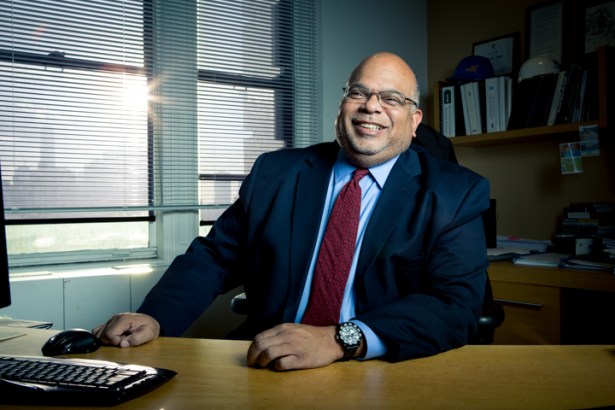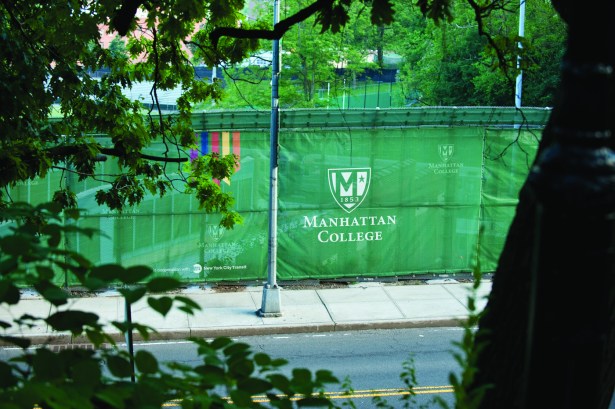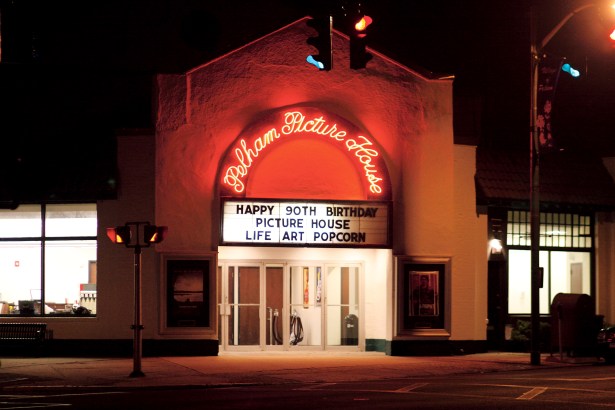Former Con Ed Honcho to Shine Light as REBNY’s Next President
By Tobias Salinger January 14, 2015 3:00 pm
reprints

The Real Estate Board of New York’s next president got his start in city government just as the board’s current president assumed the role.
In 1986, the same year Steven Spinola started his nearly three decades as REBNY president, Mayor Ed Koch’s administration hired a recent graduate of Manhattan College named John H. Banks to the mayor’s Office of Operations. In the wake of the infamous Parking Violations Bureau scandal, Mr. Koch tapped Mr. Banks to join a team investigating the cause and scope of a bribery and extortion scheme that turned the city’s political world upside down that year. The New Rochelle native was then just a youthful holder of a bachelor’s degree in economics and government who had worked as a security guard to pay his way through college. The job involved the careful examination of audits relating to nearly every city agency as the parking ticket kickback saga splashed across daily newspapers. Mr. Banks would step up years later to attempt the difficult task of filling Mr. Spinola’s big shoes, just as he didn’t hesitate to step into the challenging Koch administration post.
“When the opportunity came, I jumped on it,” Mr. Banks told Commercial Observer.
REBNY officials named Mr. Banks the organization’s next president on Dec. 9. The announcement represents the culmination of a career that has seen Mr. Banks move from City Hall to City Council to 13 years at his present position as the vice president of government and community affairs at Consolidated Edison. Mr. Banks, a married 53-year-old and father of two who now resides in Pelham Manor, Westchester, has not only served in impressive positions in his professional life. He’s also taken on voluntary functions such as participating on the boards of his alma mater and a local 1921 movie theater called the Pelham Picture House.
And REBNY’s pronouncement has drawn praise from both members and Con Edison stakeholders alike.
The varied, but successful career has placed Mr. Banks’ name in many a Rolodex belonging to prominent people at the city, state and federal levels, said his current boss, Frances A. Resheske, the senior vice president of public affairs at Con Edison.
“John knows everyone,” said Ms. Resheske, a long-time colleague and fellow Koch administration veteran. “Everyone respects him. And, after 25 years, I don’t know a single person who doesn’t like John.”
Mr. Banks will undertake the job of president-elect of REBNY on March 2, working alongside Mr. Spinola through the end of the year before taking over as president, according to REBNY officials. Asked what prompted him to throw his hat in the ring for the REBNY post, Mr. Banks said, “REBNY is the apex of advocacy in the New York political world.” Replacing the longest-serving president in REBNY’s 119-year history is no easy task, but the organization, which now boasts, at 16,000, more members than at any time in its history, will indeed rest well in Mr. Banks’ hands, Mr. Spinola said.
“We are fortunate to have John Banks as our incoming president-elect,” said Mr. Spinola in a prepared statement. “John is a consummate professional who will lead REBNY to even greater heights and successes.”
The announcement of Mr. Banks as REBNY officials’ choice has brought similar reactions from all over the city. Another formerly rank-and-file city employee currently occupies Gracie Mansion.
“I’ve known John ever since we were both young staffers working in City Hall,” Mayor Bill de Blasio said in a statement the administration released after REBNY made the hiring public. “I’ve counted him as a friend and a trusted voice who understands this city and its people. As we move forward to build and preserve more affordable housing than ever attempted before in New York City, we are excited to have John as a partner.”
North of City Hall in the Riverdale section of the Bronx, Manhattan College President Brennan O’Donnell also relies on Mr. Banks for advice, Mr. O’Donnell said. The college president has taken to calling a section of aluminum fencing that borders the campus near the track of the 1 subway train on Manhattan College Parkway, the “John Banks Fence,” he said, in honor of Mr. Banks’ help negotiating the fence’s current look with the Metropolitan Transportation Authority, where Mr. Banks also serves on the board. With Mr. Banks’ aid the Lasallian Catholic college formed a partnership with the MTA to turn an unsightly barbed-wire boundary into a green canvas-covered fence with the school’s logo.

“He’s a guy who I think has tremendous talents in all sorts of things—not the least of which is being a people person,” Mr. O’Donnell said. On REBNY’s choice of Mr. Banks as next president, Mr. O’Donnell added: “It was one of those ‘of course’ moments.”
REBNY members have also greeted the news with support. Mr. Banks has the experience necessary for the position, said Douglas Elliman Retail Group Chairman Faith Hope Consolo, even though Mr. Spinola “is a hard act to follow.”
She noted: “He’s somebody who knows how to work with the city and the administration very well. We’ve had a wonderful run and we really need someone who can work with all the new parties in play. We’re in a different time with a different administration.”
And the appointment of Mr. Banks, who will be REBNY’s first African-American president, could also help spark more conversations about diversity in real estate, said Douglas G. Giles, the executive vice president of the Council of Urban Real Estate, an organization for the advancement of minority real estate professionals, and a vice president with First Nationwide Title Agency.
“It sets the bar really high,” Mr. Giles told CO. “That says a lot, especially in an industry like commercial real estate which has always been family-driven. For them to take the most quality person—who happens to be an African-American—it speaks volumes.”
One of Mr. Banks’ prominent former supervisors in city government, Peter Vallone Sr., the first speaker of the City Council, also praised the selection. Mr. Banks, who Mr. Vallone hired as his chief of staff in 2000, “was the best you could possibly get” at the job, he said.
“He was a very valuable adviser,” Mr. Vallone told CO. “I couldn’t say anything possibly remotely bad about him. He was excellent in every respect. They’re lucky to get him.”
Mr. Banks only achieved the appointment as Mr. Vallone’s chief of staff after more than a decade in city government and short stints at the Brooklyn Union Gas Company and Con Edison.
When he started in the Koch administration in 1986, high-ranking officials at the now-defunct Parking Violations Bureau, or PVB, were resigning and facing court proceedings under the auspices of a fresh-faced U.S. attorney named Rudy Giuliani. Mr. Banks helped ensure proper procedures would be in place to prevent a repeat at other city agencies.
“There were significant numbers of management audits over the years that indicated that there were management problems at the PVB, but nobody had paid attention,” Mr. Banks said. “I was hired to go back to investigate and review all the audits of all agencies that had been audited.”
|
“John knows everyone. Everyone respects him. And, after 25 years, I don’t know |
Following the end of Mayor Koch’s last term, Mr. Banks moved to a new job as a unit coordinator for the City Council Finance Committee. Serving as what he calls “the Council’s version of the Office of Management and Budget,” the Finance Committee gave Mr. Banks, who would acquire a master’s degree in public administration from Baruch College in 1992, an even more detailed knowledge of city government. Mr. Banks helped craft and pass a bill that consolidated agencies like the Department of Ports and Trades, the Financial Services Corporation and the Public Development Corporation into today’s Economic Development Corporation, he said.
“We looked at the city’s economic development functions and there were a good eight or 10 agencies that had economic development functions,” he said. “EDC was the successor to a half a dozen smaller organizations within city government.”
Mr. Banks migrated to Brooklyn Union Gas and then Con Edison after five years at the Council, only to return at Mr. Vallone’s urging when the speaker started his run for mayor in the 2001 city elections. While working for Mr. Vallone, Mr. Banks strategized a successful override vote for a campaign finance bill that Mayor Giuliani had vetoed that year, as The Real Deal reported. But Mr. Banks had set his sights elsewhere by 2002, he said.
“The only reason I left Con Ed was that Peter asked me to,” he said. “I wanted to return to the private sector because, at that stage, I had had a 14-year career in city government and I felt it was time to move on and do something different.”
Mr. Banks then took over his current job in Con Edison’s government and community affairs division, making him one of the top lobbyists for the publicly traded company that provides electricity to 3.3 million customers in New York City and Westchester and gas to 1.1 million customers in the same area, among other services. He oversees a staff of between 30 and 40 employees who maintains relationships with area elected officials.
And, this past summer, Mr. Banks’ unit scored a major victory when state lawmakers approved a bill that allows the city and Con Edison to seek competitive proposals for complicated city construction projects together. The so-called “joint bidding” process allows city agencies to coordinate the contracts for above-ground construction with the necessary below-ground arrangements critical to all building. Mr. Banks had been working his entire current tenure with Con Edison to get the legislation passed, he said, and Ms. Resheske heaped praise on him for the work.
“It saves costs and those costs get passed right along for our customers,” she said. “Another thing it does is it eases the project. It’s a win-win for our customers and for the city. It took a long time coming but John absolutely spearheaded the effort to get it passed.”
Mr. Banks also pointed to the 2003 decision by officials at the U.S. Department of Housing and Urban Development’s to allot $750 million to rebuilding utility infrastructure lost in the terrorist attacks of 9/11 as another proud accomplishment during his time at Con Edison. Along with the lives lost that day, the company lost an electrical substation in 7 World Trade Center, an asset powering Lower Manhattan that the funds helped make operational in the new 7 World Trade Center.
“If we did not get these resources from the federal government, then the customers of Con Ed would have had to repay this bill,” Mr. Banks said. “That was something that I’m very proud of, because it saved the people of New York a tremendous amount of money.”
But Mr. Banks doesn’t only work on steering resources for his employer. He just completed his second three-year tenure as the chair of Manhattan College’s annual fund. Officials at the school, whose engineering program creates an employment pipeline from the school to Con Edison, rave about the 1985 grad’s participation in company recruitment events for current students and his stature on the school’s Board of Trustees.
“I get to work with a lot of alumni, but John is extraordinary,” said Tom Mauriello, Manhattan College’s vice president of college advancement. “John gives selflessly—both his time and his personal resources.”

Mr. Banks also sits on the board at the Pelham Picture House, a single-screen movie theater that Westchester community members purchased 10 years ago when it appeared the classic theater’s days were numbered. After a successful renovation campaign, the theater is prospering these days, with recent events like a film festival for movies made by area high school students and a screening of the Jackie Robinson biopic “42” with a post-movie discussion featuring former Robinson teammate Ralph Branca. Mr. Banks is “incredibly supportive” of the theater, said Picture House President Laura deBuys.
“He’s wonderful,” she said. “John has been very effective in dealing with community relations, government relations and corporate sponsorship.”
But, while officials at the college and the theater expect Mr. Banks to continue his roles on their boards as he makes the transition to REBNY, his colleagues at Con Edison will be searching for a replacement as Mr. Banks moves toward becoming REBNY’s next standard bearer.
“This is a wonderful job for him,” Ms. Resheske said. “And I have no doubt that we’ll continue to work together on issues that are important to the city. But he’ll be missed.”
Others close to Mr. Banks say they also look forward to watching him at REBNY.
John Calvelli, the chairman of the Picture House’s board, has been a friend of Mr. Banks since their days working together on the stage crew in high school on productions like Grease and Godspell, he said. REBNY has chosen an “incredibly gifted person” to succeed Mr. Spinola, Mr. Calvelli said.
“He is one of those great public servants,” Mr. Calvelli said. “Knowing John, I know that he sees this as the next chapter in his career serving the people of New York.”


